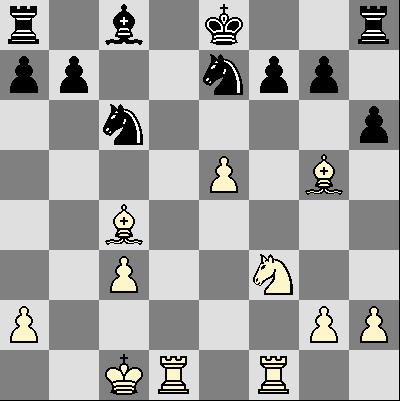It is the case of the game I played yesterday during a team chess match in Cavarzere. My team won the match 3-1, but I only drew my own game. Upon getting back home and checking an opening book, I was satisfied to see that I had found all the right moves in a opening variation unknown to me. But then I looked a bit further using a chess program, and was astounded by the tactical variation it immediately spotted (well, after six seconds to be precise). The position arises after the first few moves of a 4-pawns attack in the Alechin defence:
T.Dorigo - M.Boscolo
Cavarzere, March 18th 2012
1.e4, Nf6; 2.e5, Nd5; 3.d4, d6; 4.c4, Nb6; 5.f4, dxe5; 6.fxe5, c5; 7.d5, e6; 8.Nc3, exd5; 9.cxd5, c4; 10. Nf3, Bb4; 11.Bg5, Bxc3+; 12.bxc3, Qxd5; 13.Qxd5, Nxd5; 14.0-0-0, Ne7; 15.Bxc4, Nbc6; 16.Rf1, h6?;
The position after the 16th black move is shown below. If you are going to try and find the correct continuation, do not scroll down...

Here I did have the feeling I had to exploit the development advantage, but failed to see how I could put to work the two motives I had myself created on the board - namely, the weakness of f7 and the weakness of black's eight rank. So I just played 17.Be3, planning to re-route the bishop to c5. I obtained a slight edge but later, as the three other games of the team match ended 2.5/0.5 in our favor, I was led to agree to a draw without trying to squeeze a win. Instead, there was a move that would bring an immediate decisive advantage to white. Can you see it ?
White should now play 17.Nd4!!, disregarding the attacked Bg5. Of course if 17.... hxg5 white wins easily by 18.Bxf7+, Kf8; 19.Be6+,Ke8; with the terrible 20.Nb5!, when black is powerless.
Less obvious, however, is the right path on 17...Nxe5, which defends f7 and attacks the Bc4. But there again, the weakness of black's dark squares tells: 18.Nb5! (threatening Nc7 and mate with Rd8). Here black has a choice: hxg5, Nxc4, Nbc6, Bg4; unfortunately, all lose. Let's see how:
A) 18...., hxg5 (Nxc4); 19.Nc7+, Kf8; 20.Rd8 mate explicitates white's main idea.
B) 18...., Nbc6; 19.Nd6+, Kf8; 20.Nxf7!, Nxc4; 21.Tde1!! (not an easy move to see), Be6; 22.Rxe6, Kg8; 23.Nxh8, Kxh8; 24.Bh4, and wins;
C) 18...., Bg4; 19.Nd6+, Kf8; 20.Nxf7!, Nxc4; 21.Nxh6+, Nf5; 22.Nxg4, g6; 23.Rd7, with a crushing attack.
Further, one could question what would be the continuation if instead of 17....Nxe5 black chose 17...., 0-0. In that case, too, white gets a winning position:
18.Bxe7, Nxe7; 19.Rxf7!, Rxf7; 20.Rf1, Bf5; 21.Nxf5, Kf8; 22.Bxf7, Kxf7; 23.Nd4+!, and white remains with a pawn up in a superior ending, where only technical problems remain to be solved.
Did you see 17.Nd4 before looking at my text above ? Of course even if you did you had a simpler task than the one I faced during the game, when nobody was telling me to look very carefully to the position after 16....h6. But I think it is still not an easy move to see, in particular in conjunction with the complex variations that may arise after 17....Nxe5. Once one saw the idea of Nd4-b5, however, one would sit on the position until everything was clear...



Comments